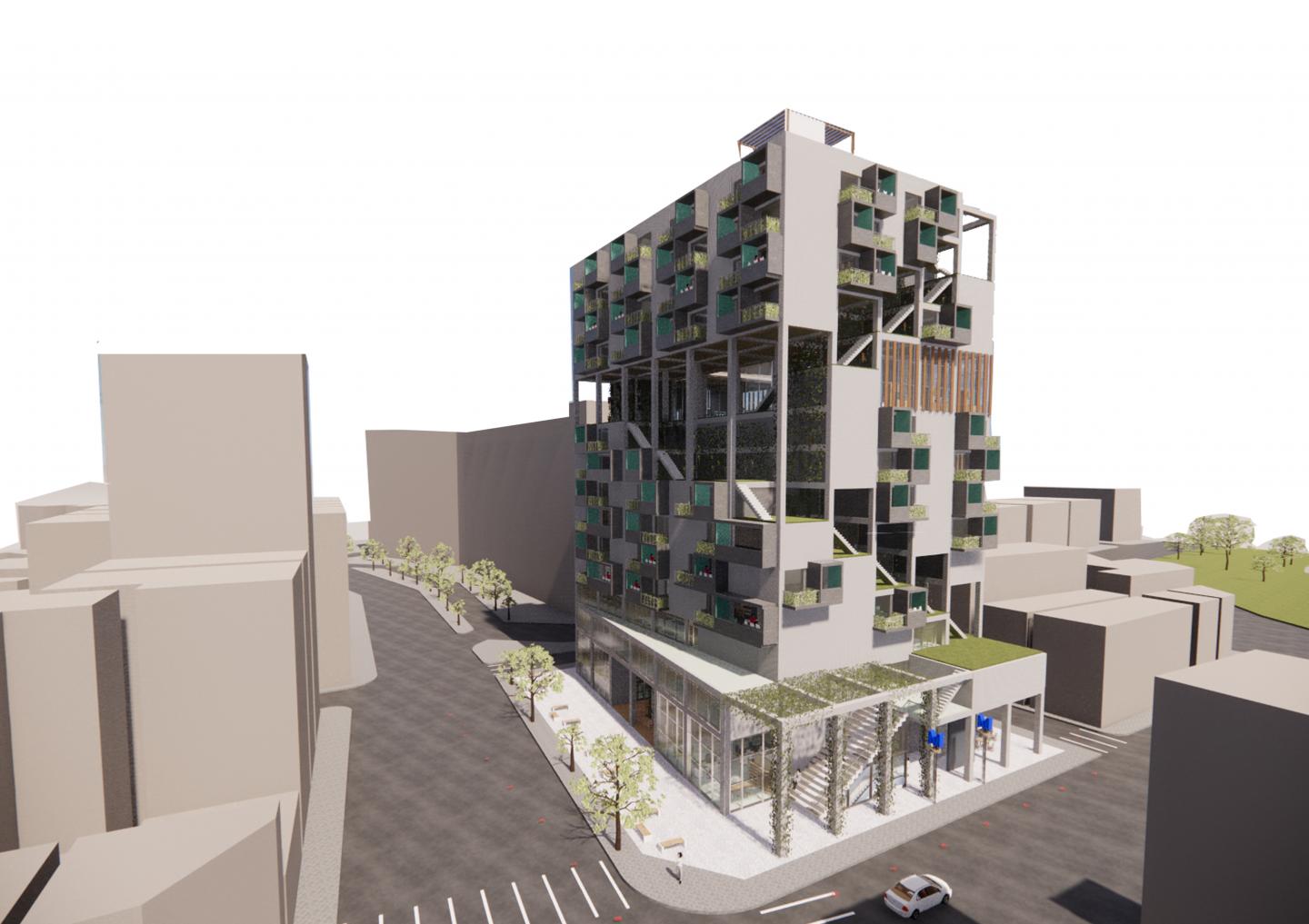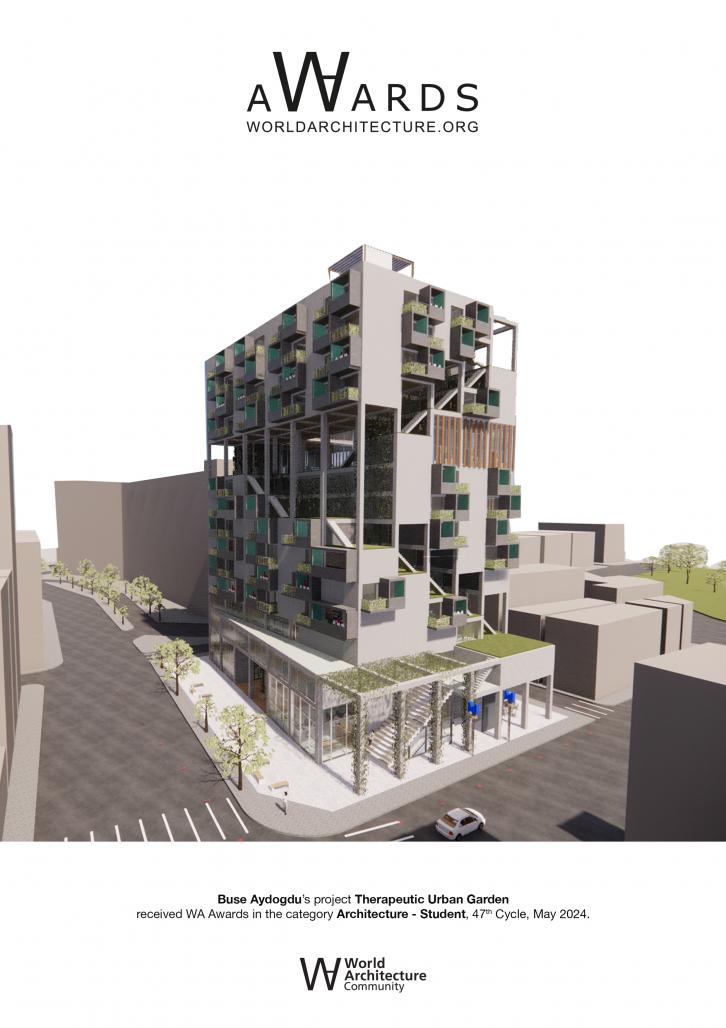''The Therapeutic Urban Garden'' project is basically a housing project. Beyond this, it is both a place where they can relieve the stress and troubles of Tokyo and a center where 'Turks' and 'Japanese' can heal the wounds of the earthquake and relax on a common ground, both soul and body.
This project is located in Yushima district of Bunkyo city, Tokyo metropolitan, Japan. The idea of Turkish and Japanese meeting about earthquakes came about after the '2023 Kahramanmaraş Earthquake' in Turkey in terms of main idea of 'Learning from housing in Japan and Earthquake design'.
The project design and concept decisions are as follows;
Tokyo and Yushima region is a crowded and stressful region with intense urban life. There is a need for people to relax, to stop and get therapy. In addition, the people who will use this place are Turkish residents and Japanese locals who will use the community activities. Beyond being a place where they can relieve the stress and troubles of city life, this place has been considered as a therapy center as it is a center where Turks and Japanese can heal their earthquake wounds. The project area and context were examined to answer the question "So what will the users receive therapy with?"
Looking at the city of Bunkyo, different plant festivals such as plum blossom, cherry blossom, azalea, hydrangea, morning glory and chrysanthemum are seen in almost every month of the year. These festivals come from the plants found in the various gardens of bunkyo. Bunkyo is known for its flower festivals, events and rich greenery. Based on this, relaxation activities such as plant workshop, plant research lab, yoga with nature, dance and music with nature, massage, plant experience and exhibition, and landscape viewing have been integrated into the residential building.
The mass strategy is as follows:
The mass is retreated from the surrounding buildings with a reference, while the lower part is used for public use, the upper part is reserved for accommodation. Although the project area is surrounded by roads and buildings on all four sides, it has two important nature factors. One of them is Ueno Park and the other is Former Iwasaki Garden. Green values such as Ueno park and Former Iwaskai Garden, where various types of plants grow, are disconnected from the city because one side of the project area is dominated by the city aspect, while the other side is connected to nature. By integrating the court idea into this project, it was aimed to both relax with nature and provide a solution to the problem of green continuity. It was thought that the land was surrounded by surrounding buildings with different functions and irregular floor heights, was surrounded by roads, and a metro line passed underneath it, and this had a negative impact on the urban exterior life. Therefore, three different entrances were given to the central courtyard, which allows the ground floor to create its own living environment and is a response to the missing urban identity, for residential, public and metro users. These three circulations were solved as follows. A residential core, one starting from the car park and ending with accommodation, and a public core starting from the public floor and ending at the metro floor, were integrated into the building. A metro core has also been added so that metro users can also take a breath from Japan's lively metro life.
The strategy in the residential masses on the upper floors is similar to the minimal living preferred by Japan due to its dense population. For this reason, modular units were built by stacking them. Unlike Japan, large urban spaces have been created where residents will enjoy the views of Ueno Park and Iwasaki Foremer Garden, where they will receive therapy among these clusters of units. These spaces were created by rotating the u shapes in two directions. Finally, the mass took its final form with the green path created by taking the gardens of Japan as a reference. Therapeutic urban garden project, a path which will form the main focal point of the project, created with removing some modules. With this greenpath, it is aimed to leave an urban memory with the sense of smell by experiencing bunkyo plants. Along the green path, from the ground floor to the roof, a courtyard was placed on the ground floor, a plant lab and exhibition were placed on the mezzanine floor, and an open cinema, music dance and co-build garden were placed on the rooftop. In summary, the idea of this housing project, which has the concept of being therapy in the city, was intended to be provided with greenpath and courtyard, with reference to the gardens of Japan. It is also thought that these two ideas will help the humid and hot weather of Japan.
2023
Considering Japan's population density, the necessity to live minimally, and also the earthquake factor, it was seen that most of its buildings had certain grid and modular operating systems. For this reason, a mass was created with a 5x6 meter reinforced concrete frame grid system. The beam thickness of the openings in the city balconies created for residents in the mass has been increased. The carrier system was revised according to the cores added to the project. An earthquake isolator was placed at the foundation of the building.
The Therapeutic Urban Garden, which is actually a housing project, is divided into three categories: old, young and adult. These were later determined as single, family and suite according to need. The distribution of units in the structure is grouped as follows:
While the family and elderly units are on one floor, the adult and young people connected to the city are on the other floor. While the elderly and family units are closer to the ground, the more energetic adult and youth units are located on the upper floors.
Finally, each unit design is designed according to the minimum square meter requirement and furniture design such as pull-out and fold-out.
Designer: Buse Aydogdu
Supervisors:
Instructor Dr. Can Gündüz
Assist. Prof. Dr. Berk Ekici
Therapeutic Urban Garden by Buse Aydogdu in Turkey won the WA Award Cycle 47. Please find below the WA Award poster for this project.

Downloaded 0 times.
Favorited 6 times


















